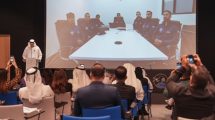
Gulf Air, the national carrier of the Kingdom of Bahrain, retrofitted six of its A330-200 aircraft with Panasonic Avionics Corporation’s Global Communications Suite. Mohamad ElAssaad, Senior Manager IFE & Communications – Gulf Air, speaks to SatellitePro ME about the choice of technology and challenges faced during the process.
“The primary reason for selecting the technology partners is that they are using Ku-band. The alternative, L-band, is a less attractive option for our passengers due to the system being more expensive and slower”
Your airline launched global live television including broadband and mobile phone services in 2011. What were the challenges faced during retrofitting?
To date a total of six aircraft have been outfitted with the global live television / broadband and mobile phone capability. Retrofitting our aircraft was a challenge since this was the first of its type in the world. The Global Communications Suite (GCS) system provides for three services including high-speed broadband with unlimited internet at affordable rates, cost-effective GSM service linked to local service providers and live TV using Ku-band satellites.
To achieve that, parts are fitted with complex architecture that includes: Ku-band antenna to provide the connection to the satellite. This type of antenna failed before due to the fact that satellites are all aligned on the equator which made it difficult to connect to a particular satellite.
In addition, equipment and technology included broadband controllers, pico cells (which act as in-flight mobile base stations), leaky feeders (improve signal propagation while reducing the amount of hardware required on the plane), Wireless Application Protocol (WAPs) and so on.
Retrofit for the first type lasted three weeks and included advanced testing to make sure that every piece of equipment fitted did not affect the safety of our aircraft. The system is light compared to its predecessors with a total weight of just 168kgs, when previous Ku-band technology such as CBB (Connexion by Boeing was an in-flight online internet connectivity service) weighed almost 500kgs.
How long does it take for equipping, testing and commissioning equipment on an aircraft and were there issues faced with coordination among the various technology partners?
The retrofit took three weeks as it involved a lengthy process of certification particularly since the system is new and proving that it is airworthy required vast cooperation from the Military Operations Area (MOA), Maintenance Repair and Operations (MRO) and Airbus. Further, the aircraft retrofit was reduced to 12 days. Having said that, it is a new production and was (and remains) very popular in the market. To find a slot for parts and MRO has been a challenge not only for Gulf Air, but for all other carriers fitting this system.
In terms of performance, what are the broadband speeds you are offering and are passengers being offered various packages?
The broadband speed is impressive; passengers are enjoying a minimum of 1MBS and unlimited download. Two packages are on offer, BHD10 (USD 26.52 approx.) for a 24-hr package, the code can be used as roaming in almost all airports and hotels, and BHD05 (USD 13.26 approx.) for 1-hr package that offers unlimited download.
Many in the industry have questioned if genuine live TV is possible in-flight. What has the performance been like aboard Gulf Air?
Yes, it is true live TV onboard our aircraft. In fact, it is the first Live TV in the world that functions over waters, using satellite technology. All other airlines that offer live TV in the market use ground routers or foot prints. In summer 2012, Gulf Air broadcast live coverage of the 2012 London Olympics games onboard our long haul flights and we launched Sport 24, the 24-hour live sports channel produced by IMG Media, broadcaster of the Formula One (F1) races, including the 2012 F1 Gulf Air Bahrain Grand Prix race hosted in Sakhir onboard our flights too.
Gulf Air passengers are enjoying live international games such as Euro Cup, World Cup, Premiere League, etc. Performance has been strong and the technology on our aircraft has truly helped fundamentally change our passengers’ communication and entertainment experience onboard.
Based on our PAXUS system analysis, almost 87% of our passengers are watching live sports – a considerable figure – and have chosen our live TV offering over any Audio or Video On Demand selections.
Did you face legal / regulatory issues before these systems were commissioned?
Yes, undoubtedly. In fact, during the certification process, Gulf Air had to certify our aircraft under Federal Aviation Administration (FAA) for aircraft without GSM, since FAA certifications are not allowed to approve any GSM service. We later had to convert the FAA certification to EASA (European Aviation Safety Agency) and commission the certification of the GSM for approval. This process alone took almost eight months.
Why did you choose to go with the Panasonic Avionics / Deutsche Telekom / Aeromobile system?
Our primary reason for selecting the technology partners is that they use Ku-band. The alternative, L-band, is a less attractive option for our passengers due to the system being more expensive and slower. We believe that Ku-band is the band is the optimum choice until Ka-band is ready for service.












Add Comment